Software Reading
"Trouble at the Interface or the identity Crisis of Interactive Art" by Erkki Huhtamo addresses the essence of interactive
art and some of the identity issues it is facing.
"By clicking a mouse, rolling a trackball, waving one's hand, jumping, shouting or pedalling a bicycle
the user was asked to realize or complete the work that would not exist without his/her actions." Unlike traditional art, interactive art
allows spectators to participate and install meanings to the work. This interaction makes the art works more profound since each interaction
provides different outcome. Huhtamo points out that most interactive art instalments require viewers to physically engage with the instalment.
Thus when internet, a medium that is relatively new and interactive, is used for artistic purpose, often they are not categorize as "interactive art"
because most of them could not successfully combine "remote interaction" on the internet and "local interaction" within a physical space. Colorflip and many other websites
by Rafael Rozendaal seem to achieve that. These pieces all allow users to achieve goals such as flipping color or fill in the blank space with physical motion by wielding
the mouse. http://www.newrafael.com/websites
Lev Manovich's "Database as Symbolic Form" discuss about database and its relation to narrative. Database is a collection of data. One of the interesting
characters of database is that there is no end to the growth of database. In addition, various data that are stored in the database might not be relevant
to each other. This is the opposite of the narrative which usually has cause and outcome. Sometimes, artists try to correlate these two ideas in an artwork.
Many Youtube users utilize this concept in their video to create
some kind of interaction in their works. One of the videos I found well executed this concept. The video starts with some kind of story(narrative). Towards
the end, the viewers are presented a few choices in order to complete the ending and the work itself. https://www.youtube.com/watch?v=eJmibLVm6AE
In "The Society of Mind", Marvin Minsky talked about how the world is formed with blocks. Not just the physical objects, but more importantly people's thoughts and
actions. Sometimes, people take the ability to do things and the idea of common sense for granted, without knowing their significance even though they appear to be easy.
Take Giant Gorilla Sculpture by David Mach(below) for example: this piece at first sight appears to be a giant gorilla, but when being examined closely, one can see that it
is build by stacks of coat hangers. This is no easy task. One must know the essence of gorilla(in terms of form and appearance) and the shape of hangers in order to construct this artwork.
